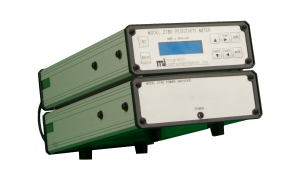Model 2180 Resistivity Meter

The unit is compact and lightweight. The basic system is 7″ wide by 2.5″ high and 12″ long. When measurements are needed below approximately 100 micro-ohm-centimeters, the basic system is piggybacked onto a second enclosure that houses a power amplifier with a current gain of ten. The combined unit measures 7″ wide by 5″ high and 12″ long. The combined unit weighs 11.5 pounds. Two short cables interconnect the two enclosures for powering the power amplifier and routing the signals to the fixture or four point probe. The front panel of the basic system includes a 32-character backlit LCD display and a set of function keys. An easy-to-use menu will allow access to user defined parameters such as sample thickness, sample volume, and calibration constants; upper and lower alarm limits, relative measurements, and several others.
The Model 2180 Resistivity Meter is used to measure the resistivity of metals. The Model F-2604 fixture is optimized for holding specimens measuring 1/4″ x 3/16″ x 41/4″ long. The fixture contains a high gain preamplifier (X20) and a four-point probe assembly whose design maximizes the voltage drop along the surface of the sample. The Model 2180 provides instantaneous measurements of resistivity for both magnetic and non-magnetic materials. Readings are displayed on a digital display and are in units of micro-ohm-centimeters. Additionally, the Resistivity Meter displays the ambient temperature in degrees centigrade. Many features included in the Model 2180 can determine the resistivity of other sizes and shapes of materials when used with other fixtures or four point probes.
FEATURES
| Resistivity Range: | 0-200 micro-ohm-cm |
| Accuracy: | 2% Full Scale, ± 0.2 micro-ohm-cm |
| Sample Resistivity Values: | |
| Material | Micro-ohm-cm |
| Iron | 9.8 |
| 1010 Steel | 13.0 |
| 4130 Steel | 22.0 |
| 304 Stainless Steel | 75.0 |
| 410 Stainless Steel | 56.0 |
| Copper | 1.7 |
| Bronze | 10.0 |
| 2024 Aluminum | 5.7 |
| 5052 Aluminum | 4.9 |
| Titanium | 48.2 |
* Specifications subject to change without notice
